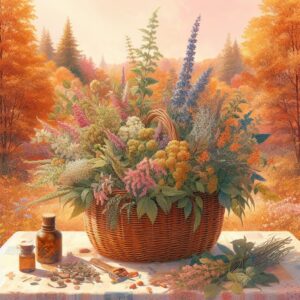Herbal First Aid Kit for Fall and Winter
HERBS
- Catnip (Nepeta cataria): Catnip, beloved by feline friends, is a mild herb known for its soothing properties. In herbal first aid, it’s often used to alleviate stress, anxiety, and promote relaxation.
- Chamomile (Matricaria chamomilla): Chamomile is a gentle herb with a delicate apple-like scent. It’s renowned for its calming and anti-inflammatory properties, making it excellent for soothing upset stomachs and promoting relaxation.
- Elder Flowers or Berries (Sambucus nigra): Elderflowers and elderberries come from the elder tree and are prized for their immune-boosting properties. Elderflower tea can help with cold symptoms, while elderberry syrup is known for its potential to reduce the duration of colds and flu.
- Peppermint (Mentha × piperita): Peppermint is a refreshing herb with a cooling menthol flavor. It’s valued for its ability to relieve digestive discomfort, ease headaches, and provide a burst of energy.
- Stinging Nettle (Urtica dioica): Despite its stinging hairs, nettle is a nutrient-rich herb. It’s often used to make nourishing herbal infusions that support overall health, providing essential vitamins and minerals.
- Sweet Basil (Ocimum basilicum): Beyond its culinary uses, sweet basil offers potential anti-inflammatory and antimicrobial properties. It can be used topically for insect bites and minor cuts or internally for digestive relief.
- White Willow (Salix alba): White willow contains natural salicylates, akin to aspirin. It’s historically used for pain relief and reducing fever. It’s considered a natural alternative to aspirin.
- Yarrow (Achillea millefolium): Yarrow is a versatile herb with astringent properties. It’s used topically to help stop bleeding from minor cuts and wounds. Internally, it’s known for its potential to reduce fever and support digestion.
These herbs, with their unique properties and applications, form the foundation of a holistic herbal first aid kit, ready to assist with various health needs and concerns.
USES
Create the herbal mixtures by combining 1/2 teaspoon of each herb. To use add 1 teaspoon of herb or herbal mixture to 1 cup of hot water. Steep 5 minutes. Strain. Drink 3 cups per day or as needed.
ALLERGIES
*Stinging Nettle
COLD & FLU
*Elder Flowers, Peppermint, Sweet Basil, White Willow, Yarrow.
HEADACHES
*Catnip, Chamomile, Peppermint, Sweet Basil, White Willow.
NAUSEA
*Chamomile, Peppermint, Sweet Basil.
SINUS CONGESTION & PAIN
*Elder Flowers, Stinging Nettle, Sweet Basil, White Willow.
ANXIOUSNESS
*Catnip
Do not boil catnip. Simply add 1 teaspoon of it to 1 cup of hot water. Steep 3 to 5 minutes and strain if desired.
BLUES and DEPRESSED MOOD
*Peppermint
Store your herbs in sealed glass or plastic containers.
Herb Supplier: www.The-Herb-Peddler.com
